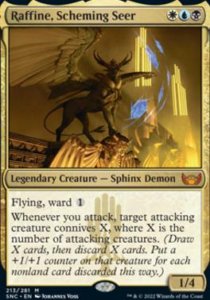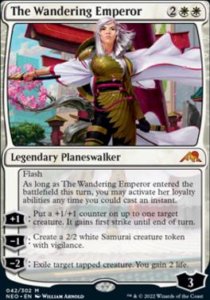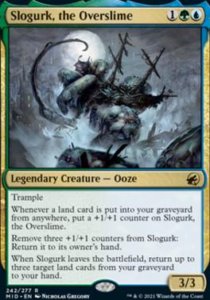If you are new here, don’t forget to check our Discord Channel. it’s free for everyone!
If you would like to see more content about Standard, click here.
Current Standard is in a healthy place – there are a lot of playable archetypes on similar power level and they differ greatly from each other in terms of gameplay and matchup matrix. As a result, the top ten decks balance each other, so there isn’t one, best deck. You can pick what you like and master it to get the few extra win percentage points you’ll need to qualify for the Pro Tour. Since there are many viable options, we’ve decided to write a short overview of the current Standard, so you can familiarise yourself with the most popular decks in the format prior to your Regional Championship.
Esper

Esper has been by far the most popular deck going into the Pro Tour, boasting over 30% presence in Seattle. It’s an inherently solid midrange deck with high card quality, flexible enough to tune for any opponent, but not all of them at once. However, its win rate at the PT wasn’t terribly exciting, and Esper’s metagame share has been seeing a steady decline ever since. It’s still one of the most popular decks in the format, but other midrange decks, like BG and 4c Legends has been steadily on the rise recently, taking away from Esper’s presence as they’re better suited to combat UW Control, which has been the most popular deck in recent weeks. Regardless of that, Esper will never be a truly terrible choice, even if it’s likely not the best one in the current metagame, and if you have enough reps with it, it’s a safe choice for the RC.
Convoke
Convoke is the best aggro deck in the format. The goal is simple – flood the board with a lot of cheap creatures and convert them into real threats with Knight-Errant of Eos or anthem effects – Imodane’s Recruiter is the most important one, thanks to granting haste on top of extra power. Others are Sanguine Evangelist (solid against decks with a lot of point removal), Case of the Gateway Express (has the added utility of being a removal spell) and Warleader’s Call. It has the best goldfish among proactive decks, and It’s quite good at dealing with point removal spells or clunky blockers, so it’s hard to stop it with generic answers. However, it suffers terribly from mass removal spells – it’s possible to rebuild after the first one, but usually the second one is game over and if the opponent has anything to close out the game, it’s very hard to come back. This helps keep Convoke in check and is eagerly exploited by basically every slower deck in the format. Domain and UW Control have access to Sunfall, Depopulate, and Temporary Lockdown. UB Control plays Deadly Cover-Up and Path of Peril is being played in basically every black based midrange and control deck in Standard. Even archetypes that aren’t usually associated with interaction, like combo and aggro deck, have access to sweepers – Temur Analyst runs a full playset of Ill-Timed Explosion, and Mono Red usually sideboards some copies of End the Hostilities. At the end of the day, Convoke is extremely powerful, but it also has a big target on its head, so everyone will respect it and pack sweepers to their 75s – the question is how many sweepers you’ll face in a fifteen round tournament.
Domain
Domain is the premier ramp deck of the format. It’s a tapout control deck with a bunch of removal spells, a few sweepers, and several ways to generate card advantage in the late game – the most iconic one is Atraxa, Grand Unifier, other notable mentions are Up the Beanstalk, Archangel of Wrath, and Herd Migration. The deck out grinds any midrange deck like Esper, Legends or BG Midrange and thanks to four Cavern of Souls, it also has a fighting chance against control decks. In game one it struggles against fast aggro decks (although maindeck sweepers help) and Temur Analyst. Both approaches are addressed with proper sieboarding strategies. Domain’s biggest weakness is its manabase – with thirteen taplands and four colour to support, it can often stumble in the early turns, which can be punished by fast starts from more proactive decks.
UW Control

UW Control has been the most popular deck in the last few weeks, and the format started to adapt to it. By far the most important pickup from OTJ for the deck was Three Steps Ahead, which is the closest we’ve got to Cryptic Command since Lorwyn was legal in Standard. Other key cards are Memory Deluge and Wandering Emperor, as well as a plethora of sweepers that can handle most creature decks. Overall, UW is a pretty well-balanced deck that has a fighting chance against anything in the format. It’s biggest problems are particularly hateful black midrange decks, with the core of Duress, Caustic Bronco, Liliana of the Veil and Hostile Investigator, as well as the 50 minute round clock coupled with slow pace of play.
UB Control
UB Control has emerged as a way to solve some of the problems that are troublesome for UW. It boasts a better matchup against Domain and Analyst decks, especially game one, since it has access to Duress and Deadly Cover-Up can exile crucial cards like Worldsoul’s Rage or Atraxa. On top of that, UB has significantly better options in terms of spot removal. In turn, it lacks a card on par with The Wandering Emperor, and struggles more against aggressive decks and sticky threats that exiling removal of UW deals cleanly with, like Mosswood Dreadknight.
Temur Analyst
Temur Analyst attacks the metagame from a different angle. It’s a combo deck that tries to slow down the game early and create an overwhelming mana advantage with the help of Aftermath Analyst, Nissa, Resurgent Animist, Spelunking and eventually Virtue of Strength. It ends the game with Worldsoul’s Rage.
Because the combo is resilient and somewhat difficult to interact with, the deck has a solid win rate in game one against the whole format. Only aggro decks like Mono Red or Toxic or fast starts out of midrange decks can steal the win by simply killing it before they execute their gameplan, but it doesn’t happen too often. However, there are a few ways to attack the deck, with the most common being graveyard hate in the form of Rest in Peace, Unlicensed Hearse and Kutzil’s Flanker. Disrupting their win conditions with countermagic and discard is a solid tactic as well, but make sure you’re prepared for their sideboard threats, like Bonny Pall, TItan of Industry or Tyrranax Rex.
BG Midrange
BG is a classic midrange deck, sporting the best average card quality in the format. Every threat offers some sort of advantage, be it cards or tempo, every removal spell is best in its class and Duress alongside Liliana of the Veil are two of the best, if not the best, anti-control measures in the current standard. Its main advantage over Esper is a better matchup in the pseudo-mirror, as well as against both UW and UB Control. On the flipside, the lack of countermagic makes Analyst and Domain uphill battles compared to midrange decks with access to blue. Overall, it seems like BG is better positioned than Esper at the moment, and if you expect little Analyst and Domain at your RC, it’s likely a very strong choice.
Legends

Legends have gained popularity in the last few weeks. It’s a midrange deck designed to go over the top of other midrange decks – the combination of Inti, Rona and Slogurk as a card advantage engine is very hard to overcome for decks like Esper or BG. It’s also quite effective against UW control. Domain is tough though, because Atraxa finding more Atraxas should still be able to grind Legends out. It can struggle against UB Control, mainly because of how Deadly Cover-Up can break Slogurk loops. Outside that, Legends don’t have any terrible matchups, and they can be a hidden gem of the current Standard. The deck has everything it needs to be great – good proactive plan, card advantage, and solid sideboard options. The main limiting factor for the deck is likely the steep learning curve of it compared to other midrange decks, and only people who put a lot of work into learning the deck, like cftsoc3, see continuous success with it.
Toxic
Toxic is an exploit deck that tries to go under every other deck in the format. It’s filled with cheap, weak creatures, but thanks to the toxic mechanic, they only need to deal ten ‘damage’. If you add to the mix the fact that the deck has access to cheap bounce spells, countermagic, and March of Swirling Mist, which often can act as a combo finisher when paired with Venerated Rotpriest, you’ll realise that Toxic is the best way to punish slower decks. It has a phenomenal Domain matchup, games against UB Control and Temur Analyst are also heavily in Toxic’s favour. UW Control is another good matchup, but they have more ways to combat our key cards. If you expect to play against a lot of slow decks that don’t produce much of a battlefield presence, Toxic will be a great pick. However, the more creatures the opponent has, the worse the matchups get. Esper is a close one, mostly since some of their two drops are quite bad against us – X/1 Deep-Cavern Bat and Faerie Mastermind matchup poorly against our 1/1s and a token from Virtue of Loyalty is a perfect target for bounce spells. BG Midrange and Legends are harder ones because their two drops (Caustic Bronco/Mosswood Dreadknight and Inti, Seneschal of the Sun/Rona, Herald of Invasion, respectively) can’t be ignored. Finally, Convoke crushes Bant, and there’s nothing that can be done to make it better. If you expect to face Convoke a lot, you definitely shouldn’t play Toxic.
Mono Red
Mono Red, sometimes with a light green splash, is in the similar position to Toxic – it has either good or bad matchups, but the spread isn’t as drastic as Toxic’s. Red aggro decks have tools to combat any given deck in the format, but it’s very hard (if not impossible) to find a right balance and have a decent matchup against control while not losing too much to midrange or aggro and so on. Nowadays, the most played version is the one with Urabrask’s Forge to punish slower decks. There’s also an option to build a deck around Slickshot Show-Off to increase the goldfish potential, but this would weaken the deck against black decks with a lot of point removal. Overall Red should be a good choice against, UB Control, UW Control and Toxic. It becomes closer against Convoke and Domain. It’s an uphill battle against midrange decks with Cut Down (so Esper, BG Midrange, Legends, etc.). Temur Analyst is also quite annoying to play against, mostly because of the lifegain attached to each fetchland activation, although cards like Cemetery Gatekeeper or Unlicensed Hearse can help.
